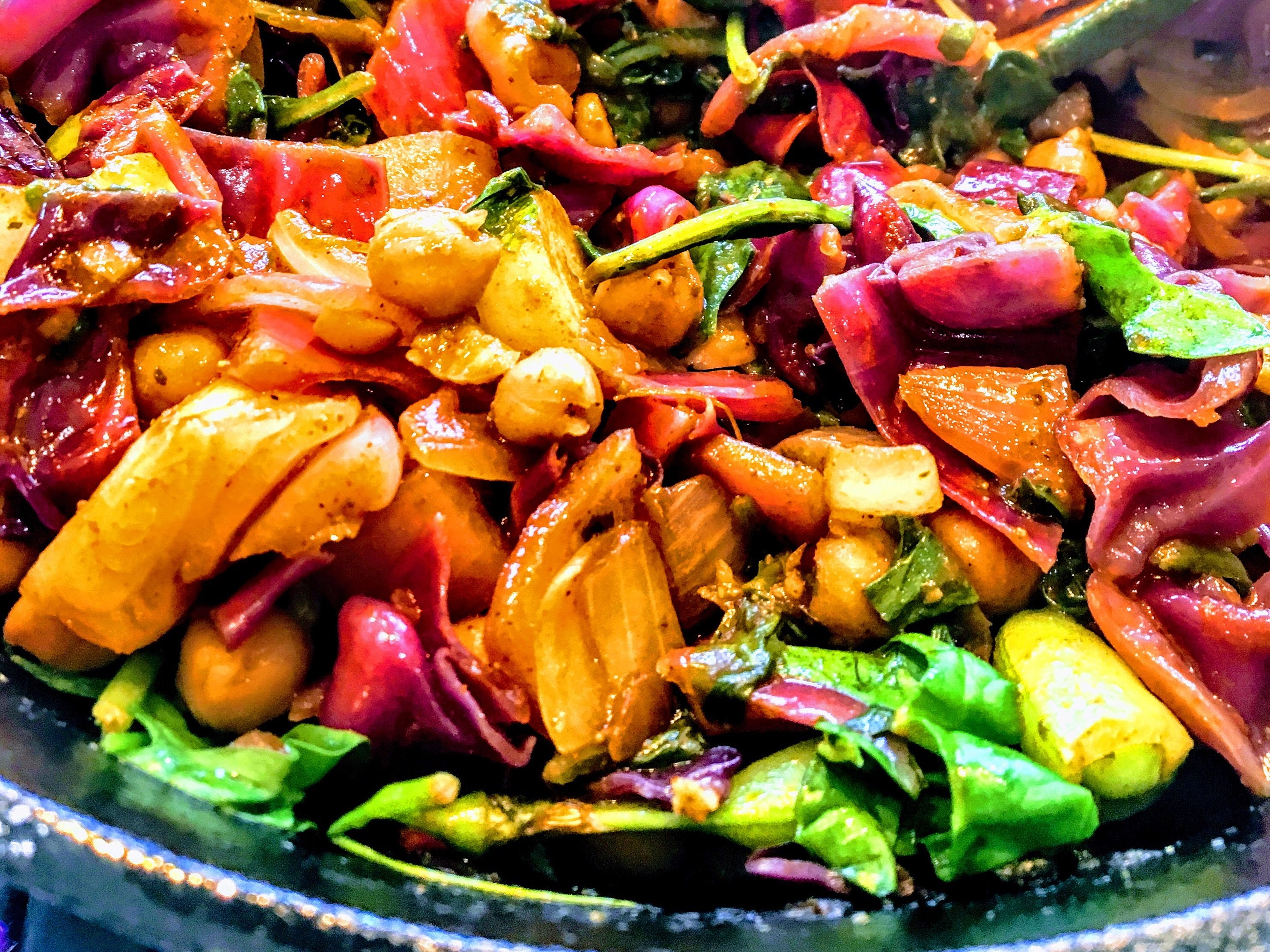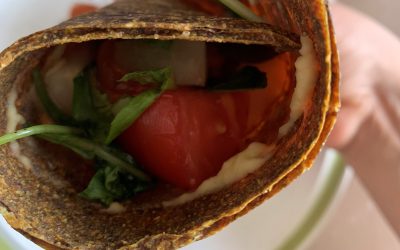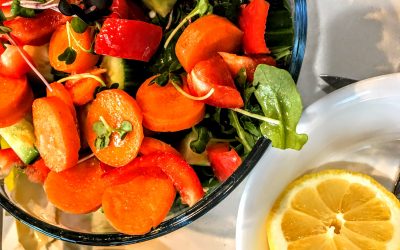Quick & Easy
Veggie Stir Fry
An Eat The Rainbow Recipe
Quick & Easy Veggie Stir Fry

Time
Prep: 10 Min
Cook: 10 Min
Ready-To-Eat: 20 Min
Diet
Vegan
Gluten Free
Grain Free
Makes
5 Full Bowls
Ingredients
- 1⁄2 jar – Patak’s Madras Curry Paste
- 1 small jar – artichoke hearts
- 1 – onion
- 1 – yellow pepper
- 1 – red cabbage
- 1 can – chickpeas
- 1 medium – zucchini
- 3 cups – spinach
Instructions
Please note: It is recommended to make veggie stir fry in a cast iron pan, as it naturally adds iron to food, and is most easily cooked without any added unwanted toxins (example: Teflon, aluminium etc). It is also, advised in ALL the recipes including this one: to use Organic and/or non-sprayed vegetables as possible. Especially watch out for The Dirty Dozen via the Environmental Work Group. renewable seed source: to reduce the toxic load and receive as many vitamins and minerals from farm to fork.
Step 1:
On medium heat; first add chopped onion to pan
Step 2:
After a few mins of caramelizing onion: add cut up cabbage (I like to cut into half inch strips, but cut as you like, this is your meal/ your creation: do what makes your heart sing ?
Step 3:
Add 1⁄4 of the 1⁄2 jar of Patak’s Madras and mix all with a large wooden spoon
Step 4:
Add rinsed off artichoke hearts, and stir
Step 5:
Add cut up zucchini and yellow pepper
Step 6:
Add the rest of the Patak’s Madras jar, and stir
Step 7:
Leave on stove top and stir until the cabbage, and zucchini has the texture you like, I prefer still partially raw/crispy
Step 8:
Lastly Add the 3 cups spinach and stir all together: at this point I turn off the stove top, since I like the spinach only slightly blanched/very lightly cooked (try out what tastes best to you: to your preference). All takes with cutting, washing, chopping, mixing and cooking 15-20 min max, depending on how strong and strong your burner is, and how cooked you like it.
Nutritional Benefits
Chickpeas
Contain significant amounts of fiber, which helps lower the total amount of cholesterol in the blood, thereby decreasing the risk of heart disease. Contains the essential minerals (that the body needs and does not create on its own): phosphorus and magnesium. Also the essential trace minerals: manganese, copper, iron, selenium, and zinc.
Artichoke Heart
They are a natural diuretic and therefore are able to help flush the body of edema to reduce bloating and overall water retention. They are a good source of folate, vitamin C, vitamin K, B-complex, potassium, iron, and antioxidants such as anthocyanins, quercetin, rutin, cynarin, luteolin and silymarin.
Cabbage
Red cabbage is an ideal food for a healthy digestive tract as it is known to help reduce bad bacteria and promote good friendly bacteria (such as acidophilus) in the gut. Red cabbage is particularly beneficial for the nervous system and has even been shown to help reduce the buildup of plaque in the brain which is one of the leading root cause of Alzheimer’s disease.
More “Eat The Rainbow” Recipes
Subscribe Today for Access to All of My Recipes
Wrawp It Good
WrawpIt GoodAn Eat The Rainbow RecipePrep: 10 Min Cook: 0 Min Ready-To-Eat: 10 MinVegan Gluten Free Grain Free2 Large WrapsIngredients 2 Wrawps ~ Wrawp is the brand IN the blue package 1 tbsp - toasted sesame oil 1 stock - spanish onion 3 thin slices - goat mozzarella...
Alive Simple Salad
AliveSimple SaladAn Eat The Rainbow RecipePrep: 5 Min Cook: 0 Min Ready-To-Eat: 5 MinVegan Gluten Free Grain Free2 Full BowlsIngredients 1-2 whole - Carrots 1 - Red pepper 1/2 - cucumber 1 handful - arugula 1 handful - spinach 1 handful - sunflower sprouts 1⁄2 - fresh...
Eating Raw Food
By Evi Spiliotopoulos
There are different schools of thought in regards to the nutritional value of eating food raw, or cooked. From my CSNN nutrition school, it was expressed from numerous sources that a traditional nutritionist standpoint is most often said for most people to find optimal health it is advised: to eat 70% raw and 30% cooked, steamed, or stir fried food. It is believed that the raw foods provide more enzymes in their raw food states.
However, with my BA major being: anthropology, I like to look at what different cultures do, and have done: in regards to optimal health. That which aligns with OurOM2hands values of being: holistic, sustainable and abundant intentions and actions. SO the two oldest most recognized forms of holistic, sustainable, abundant health seem to be: Ayurveda and TCM/traditional chinese medicine.
A close friend of mine (who is interviewed here on my vlog) states raw food is not for everyone, and may also depend on the season! Since most of us in the summer crave and want to eat more raw fruits and veggies, whereas depending WHERE you live; often in colder wintery weather more cooked or steamed root veggies are craved and wanted by the body. Have you noticed this?


I like to eat steamed or lightly stir fried food most often, especially in cooler temperatures. Although I do love raw fruit, and some simple salads like the one in recipe 1 of this Eat the Rainbow section. I find in general from warm foods: mentally, emotionally I feel overall more grounded and calm. My body also when it eats some warm cooked or steamed food, does not crave more food as I feel satisfied. When I personally eat a lot of raw food or the 70/30 ratio: I often including in warmer weather: find my digestion slows down and I feel overall more sluggish and/or mentally/emotionally spacy.
It is a personal journey to find, or rediscover WHICH foods feed you. This includes the holistic: physical/mental/emotional. Sustainable: easy to access, and prep and/or make. Abundant: brings you joy, and nourishment. As a registered holistic nutritionist I would advise if you are very confused: keep a food journal.
Food journal exercise
Keep a food journal for a minimum of one week. The food journal is a commitment to your health. This drive and discipline to optimal health may give you back in return an invaluable deepening into what YOU need which includes via food. It is an opportunity to delve into your holistic, sustainable, abundant intentions and actions ?

Advised: How to do the food journal experiment
Step 1:
It is recommended: write down each food you eat, for the duration of min one week.
Step 2:
Next, after EACH food and/or meal you eat: write down HOW you feel right after you eat
- Energy wise
- Emotionally does it do anything for you, what you just ate
- Mental clarity
- IF you notice anything about your digestion
Step 3:
Make another column in your food journal for HOW you feel 30mins AFTER you have eaten that specific food or meal. Keep in mind: The key is to leave as much room as you can to write your first and second impressions for each section. It is imperative you are open and honest with yourself on this journey, this process is all FOR YOU!
Step 4:
After the week is up, look back with a fine tooth combs, are there patterns?
Is they’re foods or meals your body seem to resonate with physically/mentally/emotionally? Was it to nourish you, or keep you stuck in a pattern of addiction (ie sugar)?



0 Comments